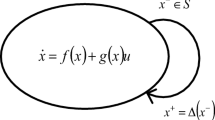Abstract
It is one of the goals of robotics to realize the autonomous robot that can cope with the unpredictably and dynamically changing environment. In order to attain the purpose under the unpredictably changing environment, a robot is usually required to solve the inverse problem. Since the imposed purpose on the system takes first priority, the system inevitably adapts to the unpredictably changing environment to attain the purpose. When the robot attains its purpose, several functions such as keeping its walking velocity, reaching its destination, keeping its proper posture etc., should be well coordinated. To coordinate several functions, the proper constraints should be self-organized from the purposes and the current states of the robot. In addition to the constraints, it is necessary some rules to fulfill these constraints. Here we propose a new real-time control mechanism to solve the inverse problem under the unpredictably changing environment.
Access this chapter
Tax calculation will be finalised at checkout
Purchases are for personal use only
Preview
Unable to display preview. Download preview PDF.
Similar content being viewed by others
References
Getting PA. and Dekin MS. (1985) Tritonia swimming: a model system for integration within rhythmic motor systems. In: Selverston AI (ed) Model neural networks and behavior. Plenum Press. New York, pp 3–20
Makino Y., Akiyama M. and Yano M., (2000). Emergent mechanisms in multiple pattern generations of the lobster pyloric network. Biol. Cybern. 82, 443–454
Kimura S., Yano M., and Shimizu, H., (1993). A self-organizing model of walking patterns of insects. Biol. Cybern. 69 183–193
Kimura S., Yano M., and Shimizu, H., (1994). A self-organizing model of walking patterns of insects II. The loading effect and leg amputation. Biol. Cybern. 70 505–512
Peason, K.G., (1972). Central programming and reflex control of walking on the cockroach. J.Exp.Biol. 56:173–193
Peason, K.G, (1976). The control of walking. Sci. Am. 235, 72–86
Graham, D., (1979a). The effects of circumo-esophageal lesion on he behavior of the stick insect Carausius morosus. I. Cyclic behavior patterns. Biol. Cybern. 32:139–145
Graham, D., (1979b). The effects of circumo-esophageal lesion on the behavior of the stick insect Carausius morosus. II. Change in walking coordination. Biol. Cybern. 32, 147–152
Foth E. and Graham D. (1983a) Influence of loading parallel to the body axis on the walking coordination of an insect. I. Ipsilateral effects. Biol. Cybern. 47:17–23
Foth E. and Graham D. (1983b) Influence of loading parallel to the body axis on the walking coordination of an insect. II.Contralateral effects. Biol. Cybern. 48:149–157
Dean, J., (1989). Leg coordination in the stick insect Carausius morosus J. Exp. Biol. 145, 103–131
Laurent, G., and Burrows, M., (1989a). Distribution of intersegmental inputs to nonspiking local interneurons and motor neurons in the locust. J. Neurosci. 8, 3019–3029
Laurent, G., and Burrows, M., (1989b). Distribution of intersegmental inputs to nonspiking local interneurons and motor neurons in the locust. J. Neurosci. 8, 3030–3039
Author information
Authors and Affiliations
Editor information
Editors and Affiliations
Rights and permissions
Copyright information
© 2002 Springer-Verlag Tokyo
About this paper
Cite this paper
Yano, M., Hibiya, S., Tokiwa, M., Makino, Y. (2002). Real-time Control of Walking of Insect; Self-organization of the Constraints and Walking Patterns. In: Asama, H., Arai, T., Fukuda, T., Hasegawa, T. (eds) Distributed Autonomous Robotic Systems 5. Springer, Tokyo. https://doi.org/10.1007/978-4-431-65941-9_44
Download citation
DOI: https://doi.org/10.1007/978-4-431-65941-9_44
Publisher Name: Springer, Tokyo
Print ISBN: 978-4-431-65943-3
Online ISBN: 978-4-431-65941-9
eBook Packages: Springer Book Archive




